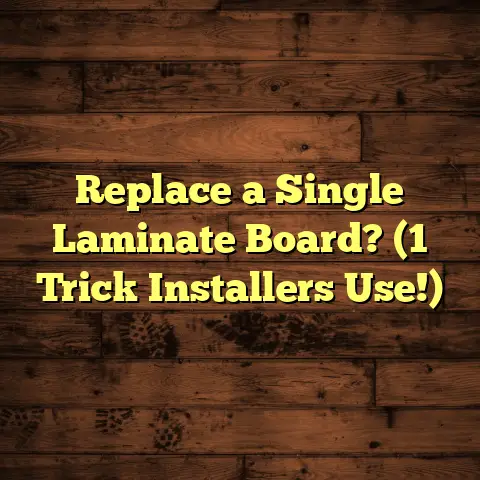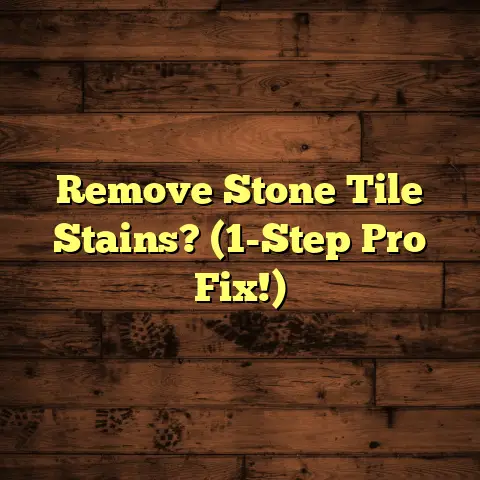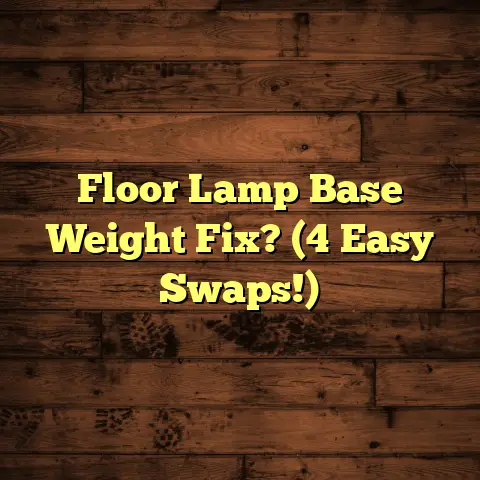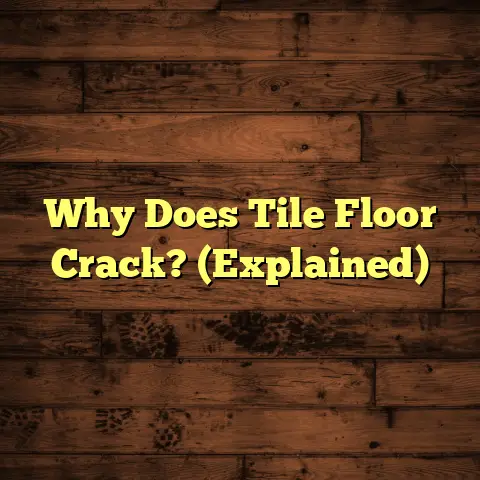Can I Put Tile Flooring Over Expoxy? (Explained)
Bold designs can transform any space, and I have always been fascinated by the impact they can have on a home. Tile flooring offers an array of styles, colors, and patterns that elevate a room’s aesthetic. However, when it comes to installing tile over existing epoxy flooring, many homeowners and contractors, including myself, often wonder: Can it be done?
In my experience as a flooring contractor, I’ve encountered various scenarios involving epoxy and tile. This article will share my insights, challenges, and successes regarding this installation process, guiding you through everything you need to know.
Understanding Epoxy Flooring
Epoxy flooring is known for its durability and glossy finish. It’s often used in garages, warehouses, and commercial settings due to its resistance to chemicals and heavy traffic. But what happens when you want to change the look of your space with tile?
Assessing the Condition of Epoxy
Before considering tile installation over epoxy, the first step is to assess the condition of the existing epoxy surface. I’ve seen cases where the epoxy was cracked or peeling, making it unsuitable for tile installation. If the epoxy is in good shape – smooth, clean, and well-adhered – you might be in luck!
Preparing the Surface
Preparation is key to a successful tile installation. Here’s what I typically do:
- Clean Thoroughly: I start by cleaning the epoxy surface to remove any dirt, grease, or wax. A degreaser can help here.
- Check for Damage: Inspect for any cracks or damages that need repair. If necessary, I use an epoxy patching compound.
- Rough Up the Surface: To ensure proper adhesion of the tile mortar, I recommend lightly sanding the epoxy surface. This creates a better bond between the tile and the epoxy.
Choosing the Right Tile
Once the surface is ready, it’s time to choose the right tile. I usually recommend ceramic or porcelain tiles for their durability and water resistance. When selecting tiles, consider:
- Size and Thickness: Larger tiles are more challenging to install but can create a seamless look. On the other hand, thinner tiles may require additional support.
- Color and Design: This is where personal style really shines! Choose a color and design that complements your space.
Installation Process
Now that we have everything prepared, let’s get into the installation process:
- Layout Planning: I always start with a dry layout to visualize how the tiles will fit in the space. It helps avoid awkward cuts later.
- Mixing Mortar: Using a quality thin-set mortar is crucial. I follow the manufacturer’s instructions for the best results.
- Applying Mortar: With a notched trowel, I spread the mortar on a small section of the floor, ensuring even coverage.
- Laying Tiles: I press the tiles firmly into the mortar and use spacers to maintain consistent grout lines.
- Grouting: After allowing the mortar to set (usually 24 hours), I proceed with grouting. It’s important to choose a grout suitable for wet areas if applicable.
- Sealing: Once the grout is dry, I apply a sealant to protect against moisture and stains.
Challenges Faced
Not everything goes smoothly in this line of work. One challenge I faced was during a project where the epoxy had been improperly applied before my work began. It led to uneven surfaces that complicated tile installation. In such cases, I had to spend extra time leveling the floor with self-leveling compound before proceeding with the tile work.
Cost Consideration
When it comes to cost estimation, FloorTally has been an invaluable tool for me. It allows me to input local material rates and labor costs easily. For example, I recently worked on a project where I needed to estimate expenses for installing tile over epoxy. FloorTally provided me with an accurate breakdown of costs involved in materials like tiles, mortar, grout, and tools.
This transparency helped me communicate effectively with my clients about budget expectations. They appreciated knowing upfront what they were getting into financially.
Maintenance Tips
After installation, maintenance is crucial to keep your new tile looking fresh:
- Regular Cleaning: A simple sweep and mop will keep dirt at bay.
- Grout Care: Ensure grout is sealed every year or so to prevent staining.
- Addressing Chips or Cracks: If any tiles chip or crack, repair them immediately to avoid further damage.
Comparing Options
If you’re still undecided about installing tile over epoxy, consider other options:
- Removing Epoxy: This can be time-consuming but may be necessary if the epoxy is damaged or you want a fresh start.
- Installing Over Concrete: If you have concrete floors beneath your epoxy, you can remove the epoxy entirely and lay tile directly on the concrete for a more stable base.
Personal Experiences with Tile Installation
Throughout my years as a flooring contractor, I’ve had countless experiences with tile installations over various surfaces. One particularly memorable project involved working in a high-end residential home where the owner wanted to install beautiful mosaic tiles over an existing epoxy floor in their kitchen.
The Project Plan
The homeowner had specific design ideas in mind—an intricate pattern that would become the focal point of their kitchen. They were excited about how this transformation would elevate their space. However, I knew we had some challenges ahead.
We started by assessing the existing epoxy flooring. Fortunately, it was in excellent condition—smooth and well-adhered with no visible signs of wear or damage.
Preparing for Installation
As we prepared for installation, we focused heavily on cleaning and roughening up the surface. I remember spending hours meticulously ensuring everything was perfect before moving forward. I often stress that preparation can make or break an installation project.
The Installation Day
On installation day, we laid out the mosaic tiles using a dry layout technique. It was exhilarating to see how all the pieces came together! I took my time applying mortar and laying each tile carefully, ensuring that every detail matched the design plan.
However, things didn’t go entirely smoothly—about halfway through laying the tiles, we realized that one of our batches had slight color variations due to manufacturing inconsistencies. We had two choices: we could either proceed and hope for the best or order a new batch altogether.
After discussing it with the homeowner, we decided to order new tiles to maintain the integrity of their vision. This delay extended our timeline but ultimately resulted in a flawless finish that matched their expectations perfectly—a decision neither of us regretted.
Final Thoughts on Tile Over Epoxy
Installing tile over epoxy flooring can be a great way to revamp your space if done correctly. The key is preparation and choosing appropriate materials. My experiences have taught me that while challenges may arise, they are often manageable with proper planning.
I encourage anyone considering this option to weigh their choices carefully—sometimes taking an extra step back can lead to a much better outcome in design.
In conclusion, would you consider this option for your flooring project? Have you faced similar situations? Whatever your choice may be, remember that seeking advice from experienced professionals like myself can make all the difference in achieving your dream space.
Additional Insights into Flooring Options
While we’ve focused on tile over epoxy here, it’s worthwhile to explore other flooring possibilities as well since decisions can often impact each other in ways you might not expect.
The Versatility of Tile Flooring
Tile flooring has various advantages that make it a popular choice for many homeowners:
- Durability: Tiles resist scratches and moisture better than most materials.
- Design Variety: From contemporary looks to classic styles, tiles can fit almost any aesthetic preference.
- Easy Maintenance: Regular cleaning is usually all that’s needed to keep them looking new.
Creative Tile Ideas
I love experimenting with different tile layouts during installations:
- Herringbone Patterns: This classic pattern creates visual interest in any space.
- Diagonal Layouts: Laying tiles diagonally can make small rooms feel larger and add dynamism.
- Inlays and Borders: Adding decorative borders or inlays can elevate a standard tile layout into something special.
Exploring Other Flooring Materials
While tile has its merits, other materials deserve consideration too:
- Vinyl Flooring: Known for its affordability and ease of installation; it’s perfect for DIY enthusiasts.
- Laminate Flooring: Offers an attractive wood-like appearance with enhanced durability and scratch resistance.
- Hardwood Flooring: A timeless choice that brings warmth but requires more maintenance compared to tiles.
Making Informed Choices
Choosing flooring can be overwhelming with so many options available today. Here are some tips based on my experiences:
- Set a Budget: Knowing your budget upfront helps narrow down choices quickly.
- Consider Usage: Think about where you are installing—high moisture areas may require specific materials like porcelain tiles or vinyl.
- Get Samples: Always ask for samples before committing—they can look different once installed!
- Consult Professionals: Don’t hesitate to seek advice from experts in flooring; their insights can save you time and money in the long run.
- Plan for Future Changes: If you might change your decor down the line, consider neutral colors that pair well with various styles.
Conclusion
Reflecting on my journey as a flooring contractor has given me valuable insights into what works best for different spaces. Whether you’re opting for tile over epoxy or exploring other flooring options altogether, remember that every project tells its own story.
What will your flooring story be? Whatever path you choose, I’m here to help guide you through it—ensuring your space reflects your unique style!





